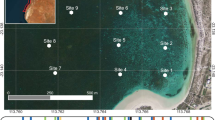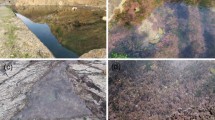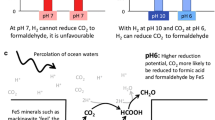Abstract
Ocean acidification damages calcareous organisms, such as calcifying algae, foraminifera, corals, and shells. In this study, we made a device equipped with a Clark-type oxygen electrode and a pH-stat to examine how the most abundant calcifying phytoplankton, the coccolithophorid Emiliania huxleyi, responded to acidification and alkalization of the seawater medium. When E. huxleyi was incubated at pH 8.2, close to oceanic pH, the medium was alkalized during photosynthesis, and the alkalization rate [determined as μmol HCl added (mg Chl)−1 h−1] was identical to the activity of photosynthesis [determined as μmol O2 evolved (mg Chl)−1 h−1]. When pH was maintained at 7.2 by the pH-stat, alkalization activity was stimulated and exceeded photosynthetic activity, resulting in an increase in the ratio of alkalization to photosynthesis (Alk/PS). On the other hand, no alkalization and photosynthesis were observed at pH 9.2. In contrast, acidification of seawater was observed in the dark because of the release of respiratory CO2 from cells at pH 8.2–9.2, but not at pH 7.2. When orthophosphate was rapidly depleted within a day in the batch culture, intracellular calcification gradually increased, and both photosynthesis and alkalization decreased gradually. During the period the Alk/PS ratio also decreased gradually. These results indicate that E. huxleyi possesses an ability to compensate for the acidification of seawater when photosynthesis is more actively driven than respiration. These results suggest that the E. huxleyi cells may not be severely damaged by oceanic acidification during photosynthesis because of their homeostatic function to avoid negative effects on cellular activity. Finally, we concluded that E. huxleyi cells possess a buffering ability to reduce acidification effects when photosynthesis is actively driven.









Similar content being viewed by others
References
Anthony KR, Kline DI, Diaz-Pulido G, Dove S, Hoegh-Guldberg O (2008) Ocean acidification cause bleaching and productivity loss in coral reef builders. Proc Natl Acad Sci USA 11:17442–17446
Axelsson L (1988) Changes in pH as a measure of photosynthesis by marine macroalgae. Mar Biol 97:287–294
Danbara A, Shiraiwa Y (1999) The requirement of selenium for the growth of marine coccolithophorids, Emiliania huxleyi, Gephyrocapsa oceanica and Helladosphaera sp. (Prymnesiophyceae). Plant Cell Physiol 40:762–766
De Beer D, Larkum AWD (2001) Photosynthesis and calcification in the calcifying algae Halimeda discoidea studied with microsensors. Plant Cell Environ 24:1209–1217
Doney SC, Fabry VJ, Feely RA, Kleypas JA (2008) Ocean acidification: the other CO2 problem. Annu Rev Mar Sci 1:169–192
Falkowski PG, Raven JA (2007) Aquatic photosynthesis, 2nd edn. Princeton University Press, Princeton
Feely RA, Sabine CL, Lee K, Berelson W, Kleypas J, Fabry VJ, Millero FJ (2004) Impact of anthropogenic CO2 on the CaCO3 system in the oceans. Science 305:362–366
Fine M, Tchernov D (2007) Scleractinian coral species survive and recover from decalcification. Science 315:1811
Goyal A, Shiraiwa Y, Tolbert NE (1992) Carbon oxysulfide inhibition of the CO2-concentrating process of unicellular green algae. Plant Physiol 98:578–583
Havenhand JN, Buttler FR, Thorndyke MC, Williamson JE (2008) Near-future levels of ocean acidification reduce fertilization success in a sea urchin. Curr Biol 18:651–652
Iglesias-Rodriguez MD, Halloran PR, Rickaby REM, Hall IR, Colmenero-Hidalgo E, Gittins JR, Green DRH, Tyrrell T, Gibbs SJ, Dassow P, Rehm E, Armbrust EV, Boessenkool KP (2008) Phytoplankton calcification in a high-CO2 world. Science 320:336–340
Jackson JBC (2008) Ecological extinction and evolution in the brave new ocean. Proc Natl Acad Sci USA 105:11458–11465
Jeffrey SW (1972) Preparation and some properties of crystalline chlorophyll c 1 and c 2 from marine algae. Biochim Biophys Acta 279:15–33
Kayano K, Shiraiwa Y (2009) Physiological regulation of coccolith polysaccharide production by phosphate availability in the coccolithophorid Emiliania huxleyi. Plant Cell Physiol 50:1522–1531
Levitan O, Rosenberg G, Setllk I, Setlikova E, Grigel J, Klepetar J, Prasil O, Berman-Frank I (2007) Elevated CO2 enhances nitrogen fixation and growth in the marine cyanobacterium Trichodesmium. Glob Change Biol 13:531–538
Liu H, Probert I, Uitz J, Claustre H, Aris-Brosou S, Frada M, Not F, de Vargas C (2009) Extreme diversity in noncalcifying haptophytes explains a major pigment paradox in open oceans. Proc Natl Acad Sci USA 106:12803–12808
Marsh ME (2003) Regulation of CaCO3 formation in coccolithophores. Comp Biochem Physiol B 136:743–754
Murata A (2006) Increased surface seawater pCO2 in the eastern Bering Sea shelf: an effect of blooms of coccolithophorid Emiliania huxleyi? Glob Biogeochem Cycles 20(GB4006):1–9
Murphy J, Riley JP (1962) A modified single solution method for the determination of phosphate in natural waters. Anal Chim Acta 27:31–36
Nimer NA, Merrett MJ (1993) Calcification rate in Emiliania huxleyi Lohmann in response to light nitrate and availability of inorganic carbon. New Phytol 123:673–677
Orr JC, Fabry VJ, Aumont OBL, Doney SC, Feely RA, Gnanadesikan A, Gruber N, Ishida A, Joos F, Key RM, Lindsay K, Maier-Reimer E, Matear R, Monfray P, Mouchet A, Najjar RG, Plattner GK, Rodgers KB, Sabine CL, Sarmiento JL, Schlitzer R, Slater RD, Totterdell IJ, Weirig MF, Yamanaka Y, Yool A (2005) Anthropogenic ocean acidification over the twenty-first century and its impact on calcifying organisms. Nature 437:681–686
Riebesell U, Zondervan I, Rost B, Tortell PD, Zeebe RE, Morel FMM (2000) Reduced calcification of marine plankton in response to increased atmospheric CO2. Nature 407:364–367
Riebesell U, Schulz1 KG, Bellerby RGJ, Botros M, Fritsche1 P, Meyerhöfer M, Neill C, Nondal G, Oschlies A, Wohlers J, Zöllnerl E (2007) Enhanced biological carbon consumption in a high CO2 ocean. Nature 450:545–548
Rost B, Riebesell U, Burkhardt S, Sültemeyer D (2003) Carbon acquisition of bloom-forming marine phytoplankton. Limnol Oceanogr 48:55–67
Satoh A, Shiraiwa Y (1992) Characterization of active transport of CO2 during photosynthesis in Chlorella regularis. In: Murata N (ed) Research in photosynthesis, vol III. Kluwer Academic Publishers, Dordrecht, The Netherlands, pp 779–782
Satoh M, Iwamoto K, Suzuki I, Shiraiwa Y (2009) Cold stress stimulates intracellular calcification by the coccolithophore, Emiliania huxleyi (Haptophyceae) under phosphate-deficient conditions. Mar Biotechnol 11:327–333
Sciandra A, Harlay J, Lefèvre D, Lemée R, Rimmelin P, Denis M, Gattuso JP (2003) Response of coccolithophorid Emiliania huxleyi to elevated partial pressure of CO2 under nitrogen limitation. Mar Ecol Prog Ser 261:111–122
Sekino K, Shiraiwa Y (1994) Accumulation and utilization of dissolved inorganic carbon by a marine unicellular coccolithophorid, Emiliania huxleyi. Plant Cell Physiol 35:353–361
Sekino K, Kobayashi H, Shiraiwa Y (1996) Role of coccoliths in the utilization of inorganic carbon by a marine unicellular coccolithophorid, Emiliania huxleyi: a survey using intact cells and protoplasts. Plant Cell Physiol 37:123–127
Shin KH, Tanaka N, Harada N, Marty JC (2002) Production and turnover rates of C37 alkenones in the eastern Bering Sea: implication of the mechanism of long duration of Emiliania huxleyi bloom. Progr Oceanogr 55:113–129
Shiraiwa Y (2003) Physiological regulation of carbon fixation in the photosynthesis and calcification of a coccolithophorid. Comp Biochem Phys B 136:775–783
Shiraiwa Y, Yokoyama S, Satoh A (1991) pH-dependent regulation of carbonic anhydrase induction and changes in photosynthesis during adaptation of Chlorella cells to low CO2. Jpn J Phycol 39:355–362
Shiraiwa Y, Goyal A, Tolbert NE (1993) Alkalization of the medium by unicellular green algae during uptake of dissolved inorganic carbon. Plant Cell Physiol 34:649–657
Veron JE, Hoegh-Guldberg O, Lenton TM, Lough JM, Obura DO, Pearce-Kelly P, Sheppard CR, Spalding M, Stafford-Smith MG, Rogers AD (2009) The coral reef crisis: the critical importance of 350 ppm CO2. Mar Pollut Bull 58:1428–1436
Welch MJ, Lifton JF, Seck JA (1969) Tracer studies with radioactive oxygen-15. Exchange between carbon dioxide and water. J Phys Chem 73:3351–3356
Zeebe RE, Zachos JC, Calderia K, Tyrrell T (2008) Carbon emissions and acidification. Science 321:51–52
Acknowledgments
This study was supported in part by the Global Environment Research Fund from the Japanese Ministry of Environment (FY2008-2010) awarded to Y.S. and T.H. (F-083).
Author information
Authors and Affiliations
Corresponding author
Rights and permissions
About this article
Cite this article
Fukuda, Sy., Suzuki, I., Hama, T. et al. Compensatory response of the unicellular-calcifying alga Emiliania huxleyi (Coccolithophoridales, Haptophyta) to ocean acidification. J Oceanogr 67, 17–25 (2011). https://doi.org/10.1007/s10872-011-0001-z
Received:
Revised:
Accepted:
Published:
Issue Date:
DOI: https://doi.org/10.1007/s10872-011-0001-z




